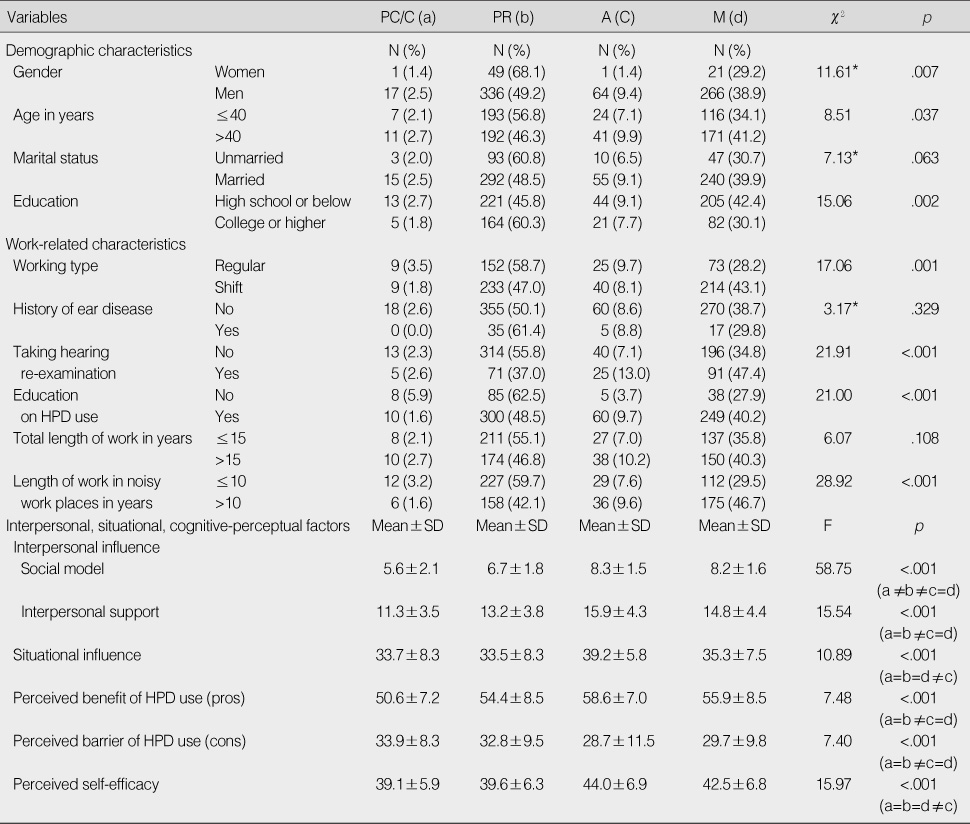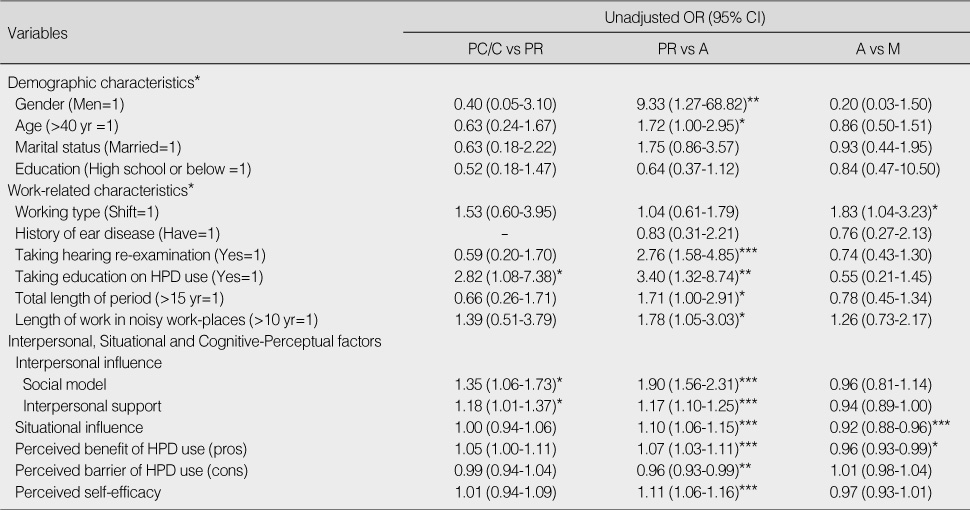Articles
- Page Path
- HOME > J Korean Acad Nurs > Volume 40(5); 2010 > Article
-
Original Article
- Change of Stages and Related Factors for Wearing of Hearing Protection Device among Noisy Workplace-workers
- Young Mi Kim, Ihn Sook Jeong
-
Journal of Korean Academy of Nursing 2010;40(5):736-746.
DOI: https://doi.org/10.4040/jkan.2010.40.5.736
Published online: October 31, 2010
1Occupational Nurse, Korea Southern Power Co. Ltd, Busan Combined Cycle Power Plant, Yangsan, Korea.
2Associate Professor, College of Nursing, Pusan National University, Yangsan, Korea.
- Address reprint requests to: Jeong, Ihn Sook. College of Nursing, Pusan National University, Beomeo-ri, Mulgeum-eup, Yangsan 626-870, Korea. Tel: 82-51-510-8342, Fax: 82-51-510-8308, jeongis@pusan.ac.kr
Copyright © 2010 Korean Society of Nursing Science
Abstract
-
Purpose
- This study was done to identify the distribution and related factors for stage of change for wearing hearing protection devices (HPDs) by workers in environments with high noise. Predictors of Use of Hearing Protection Model and Trans-theoretical Model were tested.
-
Methods
- The participants were 755 workers from 20 noisy work places in Busan and Gyeongnam. Data were collected from January to April 2008 using self-administered questionnaires, and analyzed using multiple logistic regression.
-
Results
- There were significant differences in social mode (OR=1.35, 95% CI: 1.06-1.73) between precontemplation/contemplation and preparation stage, in males (OR=2.36, 95% CI: 1.24-4.51), workers with high school education or less (OR=1.39, 95% CI: 1.28-2.78), shift workers (OR=1.50, 95% CI: 1.02-2.21), workers who previously worked in noisy places (OR=1.39, 95% CI: 1.20-2.34), and workers who had previous hearing examinations (OR=1.89, 95% CI: 1.25-2.85), in the social model (OR=1.59, 95% CI: 1.42-1.78), and self-efficacy (OR=1.05, 95% CI: 1.02-1.08) between workers in preparation and action stages, in length of time working in noisy work places (OR=2.26, 95% CI: 1.17-4.39), social model (OR=1.66, 95% CI: 1.33-2.08), and perceived benefit (OR=0.95, 95% CI: 0.93-0.97) between action and maintenance stage.
-
Conclusion
- Social model was a common factor showing differences between two adjacent stages for wearing HPDs. The results provide data for developing programs to encourage workers to wear HPDs and application of these programs in work settings.
This article is based on a part of the first author's doctoral thesis from Pusan National University.
- 1. Ahn YS, Kang SK. Analysis of occupational diseases approved by the industrial accident compensation insurance from 2001 to 2003. 2004;Seoul, Occupational Safety & Health Research Institute. Issue Brief No. 2004-43-231.
- 2. Han EJ. Analysis of stages of change in exercise behavior in office workers using transtheoretical model. 2004;Seoul, Yonsei University. Unpublished master's thesis.
- 3. Hong O, Lusk SL, Ronis DL. Ethnic differences in predictors of hearing protection behavior between Black and White workers. Research and theory for nursing practice. 2005;19:63–76.ArticlePubMed
- 4. Industrial Safety & Health Act. Ministry of Government Legislation (MOGL). 2007;04;Retrieved May 12, 2010. from http://www.moleg.go.kr/.
- 5. Jang EC, Lee Y. Study on use of personal protector and related factors of workers with hearing impairments in the noisy workplace. Journal of Soonchunhyang Medical College. 2007;13:287–298.
- 6. Kalampakorn S. Stages of construction workers use of hearing protection. 2000;Ann Arbor, MI, USA, University of Michigan. Unpublished doctoral dissertation.
- 7. Kerr MJ, Lusk SL, Ronis DL. Explaining Mexican American workers' hearing protection use with the health promotion model. Nursing Research. 2002;51:100–109.ArticlePubMed
- 8. Kim JS. Noise exposure assessment and noise reduction efficiency comparison according to improvement in a petrochemical plant. 2008;Deagu, University of Catholic University. Unpublished master's thesis.
- 9. Kim YK, Kim HJ, Lee SJ, Jang EC, Rho SC, Song JC. Factors associated with the personal protective equipments (PPEs) wearing of workers in small scale industries. Korean Journal of Occupational and Environmental Medicine. 2002;14:315–325.ArticlePDF
- 10. Kim YM, Jeong IS, Hong OS. Predictors of hearing protection behavior among power plant workers. Asian Nursing Research. 2010;4:10–18.ArticlePubMed
- 11. Kwon SJ, Kim TG, Jeong HY. Comparison of the knowledge, attitude and the preventive behavior of noise according to noise-induced hearing loss prevention education. Korean Journal of Occupational Health Nursing. 2006;15:5–13.
- 12. Lee YJ. Predicting factors corresponding to the stage of adoption for mammography based on transtheoretical model. 2003;Seoul, Yonsei University. Unpublished doctoral dissertation.
- 13. Lee YM. Process of change, decisional balance and self efficacy corresponding to stages of change in exercise behaviors in middle aged women. Journal of Korean Academy of Nursing. 2004;34:362–371.ArticlePubMedPDF
- 14. Lusk SL, Eakin BL, Kazanis AS, McCullagh MC. Effects of booster interventions on factory workers' use of hearing protection. Nursing Research. 2004;53:53–58.ArticlePubMed
- 15. Lusk SL, Hong OS, Ronis DL, Eakin BL. Effectiveness of an intervention to increase construction workers' use of hearing protection. Human Factors. 1999;41:487–494.ArticlePubMedPDF
- 16. Lusk SL, Ronis DL, Hogan MM. Test of the health promotion model as a causal model of construction workers' use of hearing protection. Research in Nursing & Health. 1997;20:183–194.Article
- 17. Lusk SN, Ronis DL, Kazanis AS, Eakin BL, Hong O, Raymond DM. Effectiveness of a tailored intervention to increase factory workers' use of hearing protection. Nursing Research. 2003;52:289–295.ArticlePubMed
- 18. Ministry of Labor. 2008 Employees health examination results. 2010;01;Seoul, Author. Issue Brief No. 11-1490000-000066-10.
- 19. Park SI, Lee YJ, Kim HS, Ahn KD, Lee BK. The effects on the wearing rate of hearing protector by checking wearing protector. Soonchunhyang Journal of Industrial Medicine. 2001;7:25–31.
- 20. Pender NJ. Health promotion in nursing practice. 1987;2nd ed. Norwalk, VA, Appleton & Lange.
- 21. Prochaska JO, DiClemente CC. Stages and processes of self-change of smoking: toward an integrative model of change. Journal of Consulting and Clinical Psychology. 1983;51:390–395.ArticlePubMed
- 22. Prochaska JO, DiClemente CC, Norcross JC. In search of how people change. Applications to addictive behaviors. The American Psychologist. 1992;47:1102–1114.ArticlePubMed
- 23. Raymond DM 3rd, Hong O, Lusk SL, Ronis DL. Predictors of hearing protection use for Hispanic and non-Hispanic white factory workers. Research and theory for nursing practice. 2006;20:127–140.ArticlePubMed
- 24. Raymond DM, Lusk SL. Testing decisional balance and self-efficacy applied to workers' use of hearing protection. Nursing Research. 2006;55:328–335.ArticlePubMed
- 25. Shin SO. Factors influencing use of hearing protection among some workers. 2004;Gwangju, Chosun University. Unpublished master's thesis.
REFERENCES


Figure & Data
REFERENCES
Citations

- Effect of the personal protective equipment donning and doffing program for nurses in military hospitals
Hyewon Lee, Ihn Sook Jeong
Nursing & Health Sciences.2022; 24(3): 690. CrossRef - Stress of Noise on Dental Technician
Ju Hee Lee
Journal of Korean Acedemy of Dental Technology.2014; 36(2): 111. CrossRef
Association of Explanatory Variables and Stage of Change in Use of Hearing Protection Devices
*Fisher exact test.
PC/C=precontemplation/contemplation; PR=preparation; A=action; M=maintenance; HPD=hearing protection devices.
Unadjusted Odds Ratio and 95% Confidence Intervals for the Use of Hearing Protection Devices by Univariate Logistic Regression
*p<.05, **p<.01, ***p<.001.
OR=Odds ratio; CI=Confidence interval; PC/C=Precontemplation/Contemplation; PR=Preparation; A=Action; M=Maintenance; HPD=Hearing Protection Devices.
Adjusted Odds Ratio and 95% Confidence Intervals for the Use of Hearing Protection Devices by Multiple Logistic Regression
*p<.05, **p<.01, ***p<.001.
OR=Odds ratio; CI=Confidence interval; PC/C=Precontemplation/Contemplation; PR=Preparation; A=Action; M=Maintenance; HPD=Hearing Protection Devices.
*Fisher exact test. PC/C=precontemplation/contemplation; PR=preparation; A=action; M=maintenance; HPD=hearing protection devices.
* OR=Odds ratio; CI=Confidence interval; PC/C=Precontemplation/Contemplation; PR=Preparation; A=Action; M=Maintenance; HPD=Hearing Protection Devices.
* OR=Odds ratio; CI=Confidence interval; PC/C=Precontemplation/Contemplation; PR=Preparation; A=Action; M=Maintenance; HPD=Hearing Protection Devices.
 KSNS
KSNS
 E-SUBMISSION
E-SUBMISSION

 Cite
Cite

